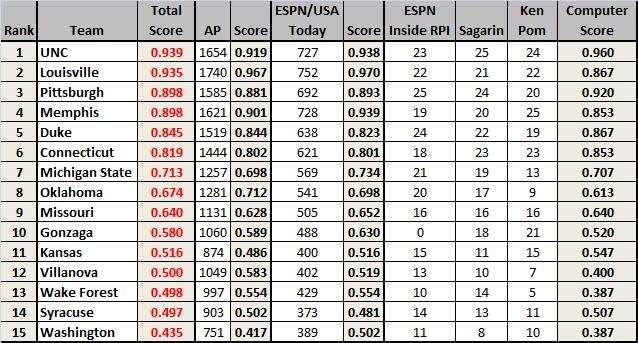That’s Debatable: What Excites Us About the 2009-10 Season
Posted by rtmsf on November 8th, 2009That’s Debatable is a new feature that we’re rolling out this season. Each week we plan on pulling out a theme or topic relevant to the 2009-10 season. Some weeks it might be embarrassingly whimsical and other weeks serious and muted. It totally depends on what the relevant news and issues are that surround the game each week. Our editors and primary writers will contribute most weeks, but often we’ll ask other friends, writers and correspondents to send us something if they’re particularly well-suited for that week’s topic. To make it palatable, each writer’s argument will be limited to 200 words: brevity will be just as important as the points being made. We hope to have fun with it and encourage you to join us in the comments.
This week’s topic: What Excites You About the 2009-10 Season?
zach hayes – editor/contributor, RTC.
I’m most looking forward to the return of the great rivalries that college basketball provides. Whether it’s the powder blue of the Tar Heels marching onto the Cameron Indoor floor, the Georgetown grays battling down low with the orange of Syracuse, or the Jayhawks walking into the pandemonium of Manhattan, Kansas, I cannot wait for these rivalry flames to be sparked yet again. It’s not just the major conferences that provide hatred and bitterness: what about Xavier and Dayton doing battle for the A-10 title this year, Northern Iowa and Creighton as MVC foes atop the standings or Nevada and Utah State out west? Think about the individual rivalries that could bloom this season: Luke Harangody banging with Samardo Samuels inside, Edgar Sosa trying to contain John Wall and Robbie Hummel looking to stay with Evan Turner in the midwest. Even the coaching rivalries will spark up: John Calipari vs. Bruce Pearl, John Calipari vs. Rick Pitino, John Calipari vs. Jim Calhoun… you get the picture. What makes college basketball so fun is the intensity and passion. Nothing exemplifies those two qualities more than these historic rivalries.
rtmsf – editor/contributor, RTC.
And so it begins. Within a matter of a few hours we’ll hear the first squeaks of rubber against hardwood, we’ll smell the popcorn wafting through the air, and we’ll feel the all-t0o-familiar mixed pangs of pride, sentimentality and adrenaline as we get to know these institutions all over again. For people like us, today is Christmas without the tree or Easter without the Bunny. But the presents are better. Instead of an ugly tie and processed marshmallow candy we don’t need, the presents are getting to know the next-gen players like John Wall, Derrick Favors and Lance Stephenson. It’s wondering which teams will come out of literally nowhere like Washington State in 2007, Drake in 2008 or Missouri in 2009. It’s breaking down schedules and trying to figure out creative ways to match family vacations with top ten matchups. It’s dreaming of 6 OTs and upset Saturdays and a 24-hour orgy of televised hoops. This season, as every season, the cellophane-wrapped newness excites us with its pristine, shiny facade. Anything is possible. Everything is possible. What excites us about the 2009-10 season? Its existence. Let’s tip it off and watch the beauty unfold, shall we?
john stevens – editor/contributor, RTC.
“Preseason” tournaments. Big Monday. Conference challenges. Bill Raftery referencing lingerie. Philadelphia’s Big 5. The joy of Gus Johnson. The late-night west coast game (in the East). Mid-majors. Kalin Lucas. Buzzer-beaters. Championship Week. Verne Lundquist and Len Elmore. The sounds of rubber on hardwood and leather through string. Majors. A screaming Gary Williams. The concurrent holiday season. Dick Vitale. The love/hate of Duke. The (presumed) resurrection of Kentucky. The defending-champ entitlement of Carolina. The hope of Purdue, Texas, Butler. Luke Harangody. The perseverance of Miss Andrews. Low-majors. Rihards Kuksiks‘ shooting form. Conference play. Kyle Whelliston’s Mid-Majority (and Bally). Dance teams. Gordon Hayward. Road trips to games. Student sections. The early-season importance of Dayton-Creighton. The enormity of Duke-UNC. The new Spring. Bubbles. Selection Sunday. Burst bubbles. The first two rounds. The Four. Monday night.
This is about one hundredth of what I could write. I’m excited about this season in the same way that I get excited in those minutes waiting in an airport before a relative or a good friend steps off the plane. It’s the return of something I love, and because it’s been gone for so long.
nvr1983, editor/contributor, RTC.
Two things stick out for me: Kentucky’s freshman class and the potential emergence of a mid-major as a threat in March/April.
- Kentucky’s freshmen have been one of the major stories of the offseason after Kentucky fired Billy Gillispie and hired John Calipari who had put together one of the top recruiting classes since Michigan’s famed Fab 5. Although Calipari lost Xavier Henry to Kansas when he moved to Kentucky, his incoming class with Patrick Patterson might be enough to get him a chance to face Henry in April.
- While college basketball has a tournament that college football fans can only dream about that gives the little guy a chance it seems like the talk of the rise of the mid-major has been premature. In the past five years only one mid-major (outside of Memphis) that was feared coming into March has advanced to the Elite 8 (#3 seed Xavier in 2008). While Gonzaga (all hype in March since Casey Cavalry’s sophomore season) and George Mason (one fluky run) are nice I am looking for something more substantial. Right now the top candidates are Butler, Dayton and Siena. I’ll be watching to see if someone steps up.







































![14709032855_Villanova_v_Pittsburgh[1]](http://rushthecourt.net/wp-content/uploads/2009/10/14709032855_Villanova_v_Pittsburgh1.jpg)

















